Snatch Deadlift
Author:
Unlock your full potential by engaging with our experts and community! Have questions about your fitness journey or looking for expert advice on weightlifting techniques? Don’t hesitate — leave a comment below and Oleksiy Torokhtiy will provide a personalized answer and insights to help you reach your goals.
Torokhtiy is reader-supported. Some links are affiliate links, and we may earn a commission at no extra cost to you. See our disclosure page for details.
What Is a Snatch Deadlift?
It is almost the regular deadlift from the platform but performed with a wide grip. Its technique consists of the same positions as the snatch pull but without the explosion, trap work, and heel rise. The snatch deadlift works great for increasing lower body and upper back strength but with no explosive component.
Some weightlifters prefer a wider snatch grip since it is more comfortable for the lower back.
Snatch grip deadlift is a basic exercise for snatch training in terms of strength, control, and balance. Athletes usually do snatch grip deadlift with heavier weights than the snatch which allows them to increase their strength significantly. Snatch grip deadlift can be also used with light weights in order to correct balance and body positions in the pull or as a tool for snatch learning.
🔻Find Your Best Training: Take Our Quiz!
Are you ready to learn and grow? Take our simple quiz to discover the right training program for you. Let us help you succeed — click below to start the quiz!
What muscles are involved in barbell snatch grip deadlift?
The barbell snatch grip deadlift is a compound exercise that targets several muscle groups throughout the body, including:
1. Hamstrings
The hamstrings are the muscles on the back of the thighs and are heavily involved in the barbell snatch grip deadlift. These muscles work to extend the hips, which is a key movement in the lift.
2. Glutes
The glutes are the muscles in the buttocks and are also heavily involved in hip extension during the barbell snatch grip deadlift. They work together with the hamstrings to generate force and power during the lift.
3. Lower back
The lower back muscles, including the erector spinae, work to maintain a neutral spine position during the barbell snatch grip deadlift. These muscles help to support the weight of the bar and prevent injury.
4. Quadriceps
The quadriceps are the muscles on the front of the thighs and work to extend the knees during the lift. While they are not the primary muscle group involved in the snatch grip deadlift, they do contribute to the movement.
5. Upper back and shoulders
The upper back and shoulder muscles, including the trapezius, rhomboids, and deltoids, are involved in maintaining proper posture and stabilizing the bar during the wide grip deadlift.
6. Forearms
The forearms are involved in grip strength and maintaining control of the bar during the lift.
Overall, the barbell snatch grip deadlift is a comprehensive exercise that engages a variety of muscle groups throughout the body. It can help to build overall strength, power, and muscle mass, as well as improve posture and athletic performance.
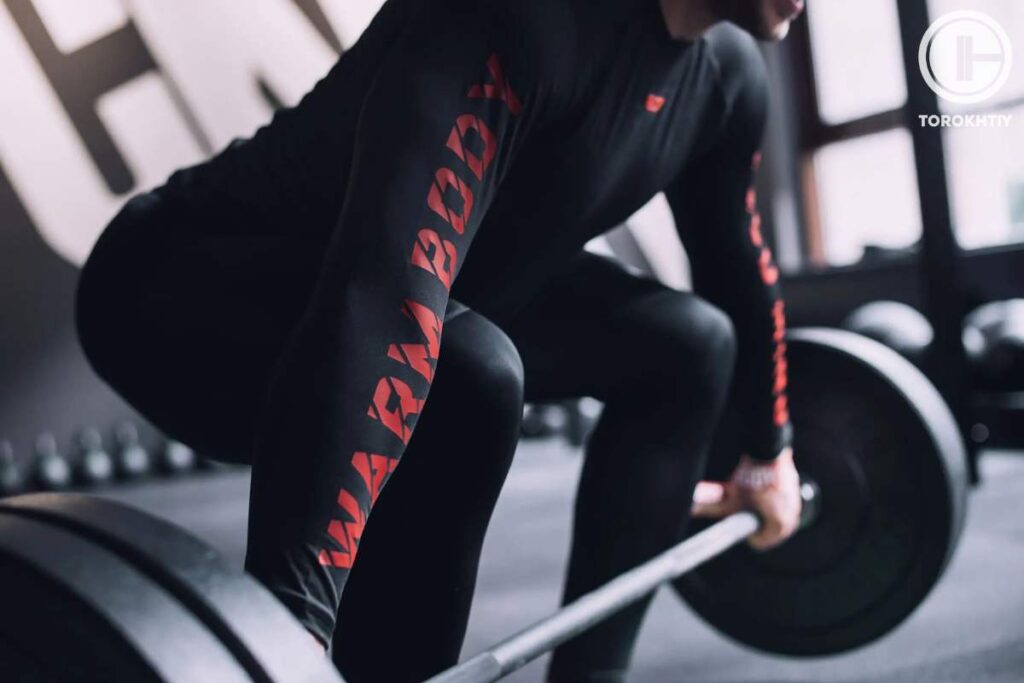
Snatch grip deadlift benefits, compared to the traditional deadlift
1. Upper back work
The snatch deadlift involves almost the same muscles as the traditional deadlift. However, it puts more tension on the upper back rather than the lower part due to a wide grip. Thus, it comes in handy if you aim to strengthen this area.
2. Increasing the range of motion
The snatch deadlift is an exercise longer than the traditional deadlift. A wider grip means that you have to drive your hips more backward to perform the movement. It targets your hamstrings and upper back more specifically and can be helpful to progress in other exercises, including traditional deadlifts.
3. Improving hip mobility
A lower starting position also improves hip mobility which is a vital movement in our daily life.
4. Additional variety
In order to keep progressing, you have to do the same exercise for several weeks. It is usually reached by adding kilograms, reps, or sets week by week. However, linear progress will come to an end one day. Once it happens, exercise variety can be used to break through a strength plateau.
It also helps you psychologically. Any changes in usual exercises make training more interesting. It may seem obvious, but training joy is critical for sticking to a program for a long time.
5. Deadlift progress
Basically, the snatch deadlift is a more complicated variation of the traditional deadlift.
Firstly, a wider grip makes you bend more downward to grab the bar. A low starting position means a longer range of motion which helps to enhance the lower part of the deadlift.
Apart from that, a wide grip makes an athlete lift a weight higher to reach the lockout. Compared to the regular deadlift, in this variation, the final bar position moves further up.
Such an increase in the range of motion makes the snatch deadlift more difficult than the traditional option.
6. Snatch progress
The snatch deadlift is very similar to the snatch. Therefore, it is often used by Olympic weightlifters as an accessory exercise. It serves both to increase training volume and correct technical elements. In order to improve the proper snatch mechanics, you should do the snatch deadlift with eccentric pace, pauses, or partial movements.
7. Grip strengthening
It goes without saying that the deadlift strengthens the grip. Meanwhile, the snatch deadlift can take your grip to another level in case you regularly do it without straps. A wider grip puts the wrists at an angle that doesn’t allow all fingers to cover the bar, compared to the traditional deadlift. If you do such additional holding work for weeks and months, it will definitely boost your grip strength.
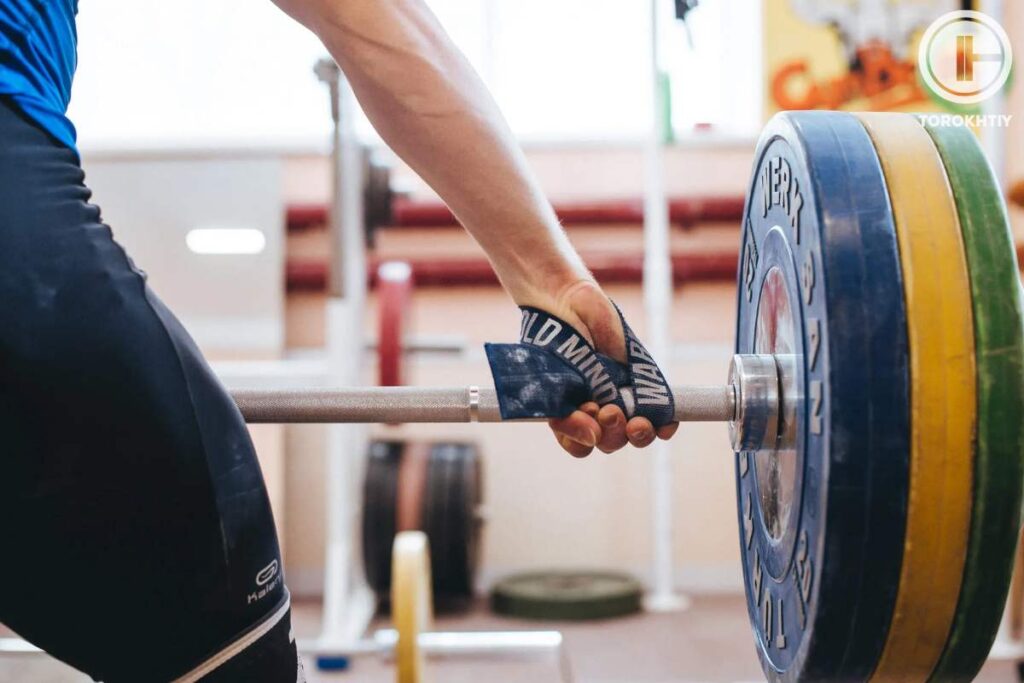
However, the snatch deadlift has a few downsides.
Though it is a great deadlift and snatch variation, this exercise has a few cons as well.
1. Grip difficulty
As was stated before, a wider grip in the snatch deadlift puts the wrists on the bar at an angle. It means that it is difficult to fully cover the bar with fingers and, thus, harder to hold it.
Grip strength often turns out to be a limiting factor in the snatch deadlift. Therefore, you have to lift lighter weights (that may not initiate adaptation) or use straps for regular sets.
2. Lighter working weights
Athletes tend to lack upper back strength and, therefore, bend their spine.
If you struggle with this problem, you should decrease working weights compared to the regular deadlift.
Technique
Let’s look at all parts and elements of this exercise in more detail.
Basically, the snatch deadlift copies the snatch up to the power position. The movement starts at the platform and lasts to the full trunk extension. In this exercise, the emphasis is put on critical positions and speed.
1. Starting position
If you are a novice athlete, choose a rather lightweight so that you can confidently handle 8-12 reps.
Then, make sure that the position is correct. For this exercise, you need to hold the bar with a wide grip. The arms must be stretched throughout the whole movement. The toes and knees should point out in the same direction.
In order to find the proper hand position, take a test with a PVC pipe. Raise one of your hands and put the other one to the side parallelly to the floor. The angle between your arms should be 90°. Put your hands down and you will have the proper snatch grip.
Place your feet so that the bar projection is on the toe phalanges. Use the shoulder-width stance and keep the mid-foot balance. Grab the bar with the snatch grip. Look in front of yourself, open the chest, and squeeze the shoulder blades. Arch the back and keep the shoulders over the bar.
2. Lift-off
Once you set up, start working with your legs: push them against the platform and stay flat-footed. Keep the shoulders right over the bar. Your chest and hips should move simultaneously.
The bar should travel as close to the shins and thighs as possible till you stretch the hips and knees. It is important to keep the arms straight and relaxed throughout the whole movement up to the full extension. Return the bar slowly to the starting position. It is 1 rep.
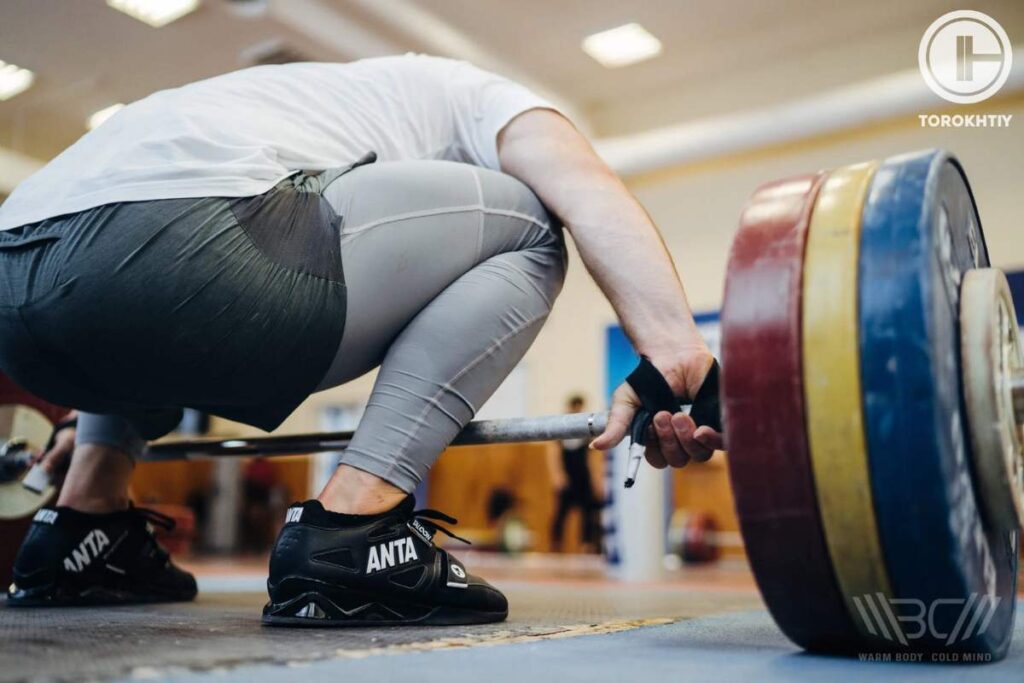
Who needs the snatch deadlift?
No matter what your weightlifting experience is, snatch dl is a must-have exercise in a training program.
1. If you are a beginner
It is worth practicing the snatch deadlift in order to learn the main positions and angles from the platform up to the power position.
2. If you are an experienced athlete
The snatch deadlift is a great exercise within the preparatory and transition periods for building your strength reserve.
3. Athletes from other sports
Strength work during the off-season is an essential part of reasonable training for American football, basketball, tennis players, boxers, etc. They all use squats and deadlifts as their basic exercises. Also, they often do the snatch deadlift from the hang position or knee-level blocks if they don’t want to overload the back.
4. Functional Fitness
Snatch grip deadlift can be a useful exercise for fitness. Here are a few reasons why:
Improves grip strength: The snatch grip deadlift requires a strong grip to hold the bar, which can help to improve grip strength. This can be beneficial for other fitness exercises that also require grip strength, such as pull-ups, muscle-ups, and kettlebell swings.
Develops overall strength: The snatch grip deadlift is a compound exercise that works several muscle groups throughout the body, including the hamstrings, glutes, lower back, and upper back. This can help to develop overall strength and power, which can be useful for other fitness exercises that require strength, such as the clean and jerk or the snatch.
Enhances posture and body awareness: The snatch grip deadlift requires a neutral spine position, which can help to improve posture and body awareness. This can be beneficial for other exercises that require good posture, such as squats and deadlifts.
Overall, the snatch grip deadlift can be a useful exercise for fitness as it targets several important muscle groups and can help to develop overall strength and power, improve posture and body awareness, and enhance explosiveness.
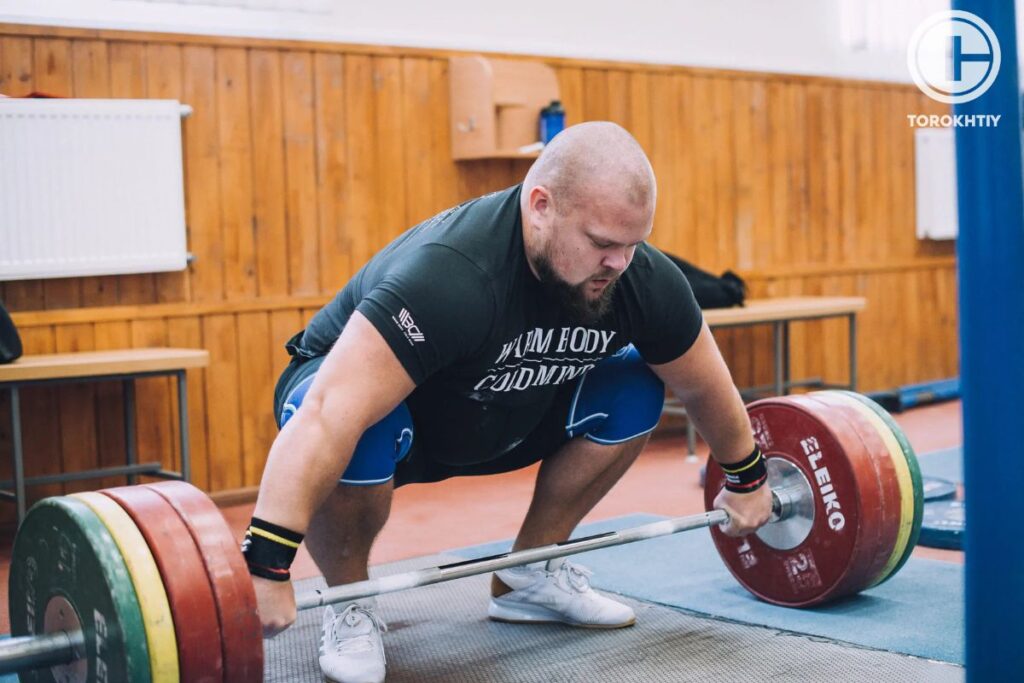
Snatch deadlift variations
There are plenty of snatch deadlift variations. It is worth choosing them according to your needs and training peculiarities.
1. Paused Snatch Deadlift
You can vary a pause position and its length (2-6 seconds) to complicate the exercise and focus on a particular point. Usually, it is made at the lift-off, below or above the knees, at the power position, or at the lockout. In order to make the exercise even more difficult, try adding a few pauses both during the upward and downward movement. For example, if you work on your technique, a 2-3-second pause at the knee level allows you to feel the feet balance, fix the leg and back position, relax the arms and after that accelerate the bar and do your best in the explosion.
2. Deficit Snatch Deadlift
This variation teaches an athlete to ‘endure’ the pull, constantly accelerate and reach the highest amplitude. This exercise is essential for athletes with weak back muscles who struggle at the lift-off or just lack physical strength.
3. Block Snatch Deadlift
The block snatch deadlift is a variation of the snatch deadlift that is performed with the barbell starting from blocks or elevated platforms. The blocks are usually placed at various heights to allow for different starting positions, which can be used to target different parts of the lift.
The block snatch deadlift is similar to the conventional snatch deadlift, but the starting position is higher due to the blocks, which means that the lifter does not have to pull the barbell as high off the ground. This can be helpful for lifters who struggle with the initial pull of the snatch and need to focus on building strength in this area.
To perform the block snatch deadlift, the lifter starts with the barbell on blocks at the desired height. The lifter then assumes the same starting position as the snatch deadlift, with the feet shoulder-width apart, the shins vertical, and the back straight. The lifter then pulls the barbell off the blocks and performs the deadlift, using the same technique as the snatch deadlift.
The block snatch deadlift can be used in snatch-specific training programs to improve the initial pull of the snatch, as well as in general strength and power programs to develop the muscles used in the snatch deadlift. It can also be used as a warm-up exercise for the snatch, or as a way to add variety to training programs.
4. The snatch grip Romanian deadlift
The snatch grip Romanian deadlift (RDL) is a variation of the Romanian deadlift exercise that uses a wider grip on the barbell, similar to the grip used in the snatch. In this exercise, the lifter stands with a wider grip on the barbell and then hinges at the hips to lower the barbell down the front of their legs, maintaining a slight bend in the knees and a flat back. The snatch grip RDL targets the muscles of the posterior chain, including the hamstrings, glutes, and lower back, as well as the upper back and grip muscles due to the wider grip on the barbell. This exercise is often used by weightlifters and other athletes as a way to improve strength and stability in the snatch, as well as to build overall strength and power in the lower body.
Common mistakes when performing the snatch grip deadlift:
Using the arms to lift the weight: The snatch grip deadlift is a lower body exercise that primarily targets the hamstrings, glutes, and lower back. Some people make the mistake of using their arms to lift the weight, which can put unnecessary stress on the shoulders and decrease the effectiveness of the exercise. To avoid this, focus on driving through the legs and hips to lift the weight.
1. Rounding the back
Rounding the back during the snatch grip deadlift can increase the risk of injury to the lower back. To avoid this, keep your back flat and engage your core to maintain a neutral spine position throughout the exercise.
2. Not engaging the lats
The lats (latissimus dorsi) are the muscles in the upper back that help to stabilize the weight during the snatch grip deadlift. Some people make the mistake of not engaging their lats, which can cause the bar to drift away from the body and make the lift more difficult. To engage your lats, imagine pulling the bar towards your body as you lift.
3. Lifting with the feet too wide
The snatch grip deadlift is typically performed with a wider stance than a conventional deadlift, but some people make the mistake of positioning their feet too wide. This can make it more difficult to engage the legs and hips, and can also increase the risk of injury. To find the proper stance, position your feet slightly wider than shoulder-width apart with your toes pointing out at a slight angle.
4. Not using proper form
As with any exercise, using improper form during the snatch grip deadlift can increase the risk of injury and decrease the effectiveness of the exercise. To avoid this, focus on maintaining proper form throughout the lift, including keeping your back flat, engaging your core, and driving through the legs and hips to lift the weight.
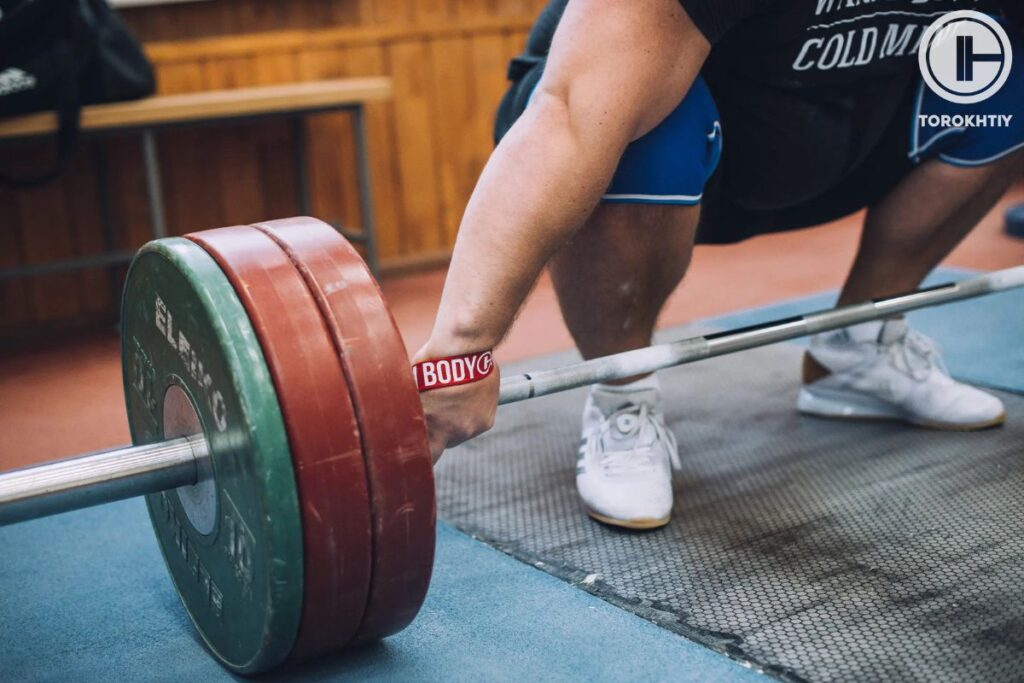
Snatch Grip Deadlift Programming
When programming snatch grip deadlifts, there are a few main points to consider:
1. Sets and Reps
The number of sets and reps will depend on your training goals and experience level. For strength and power development, lower reps (such as 1-3) with heavier weight are often used, while higher reps (such as 4-12) with lighter weight can be used for muscular endurance and hypertrophy.
2. Load
The weight used for snatch grip deadlifts will depend on your training goals and experience level. For strength and power development, heavier weight is typically used, while lighter weight can be used for muscular endurance and hypertrophy.
3. Progression
To make progress in the snatch grip deadlift, you should gradually increase the weight over time. This can be done by adding weight to the bar, or by using other training methods such as drop sets, pyramids, or wave loading.
4. Frequency
The frequency of snatch grip deadlift training will depend on your training goals and experience level. For strength and power development, training once or twice per week may be sufficient, while for muscular endurance and hypertrophy, more frequent training (up to 3-4 times per week) may be necessary.
5. Technique
Proper technique is essential when performing snatch grip deadlifts. It is important to maintain a neutral spine position throughout the lift, engage the lats to stabilize the weight, and drive through the legs and hips to lift the weight. Video analysis or working with a coach can be helpful in improving technique.
Also Read:
Why Trust Us?
With over 20 years in Olympic weightlifting, strength training, nutrition coaching, and general fitness our team does its best to provide the audience with ultimate support and meet the needs and requirements of advanced athletes and professional lifters, as well as people who strive to open new opportunities and develop their physical capabilities with us.
By trusting the recommendations of our certified experts in coaching, nutrition, and sports training programming, as well as scientific consultants, and physiotherapists, we provide you with thorough, well-considered, and scientifically proven content. All the information given in the articles concerning workout programming, separate exercises, and athletic performance, in general, is based on verified data.
The product testing process is described in more detail here.
Author: Oleksiy Torokhtiy
Olympic Weightlifting Champion, PhD in Sport Science
Best Results: Snatch – 200 kg,
C&J – 240 kg
Oleksiy Torokhtiy is a professional athlete boasting 20 years of experience in Olympic weightlifting. With multiple European and World titles under his belt, he has showcased his prowess in two Olympic Games (Beijing 2008 and London 2012). Upon concluding his illustrious career, Oleksiy dedicated himself to coaching. By 2022, he had conducted over 200 weightlifting seminars worldwide. He is the visionary behind an international sportswear and accessories brand known for its motto, “Warm Body Cold Mind.” Additionally, he is an esteemed author and the creator of a series of training programs and eBooks.






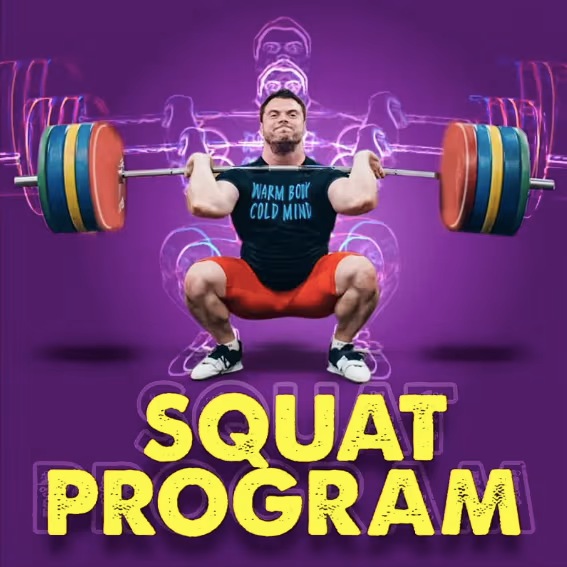


Still have questions after reading our article? Unlock your full potential by engaging with our experts and community! Don’t hesitate — leave a comment below and Oleksiy Torokhtiy will provide a personalized answer and insights to help you reach your goals.